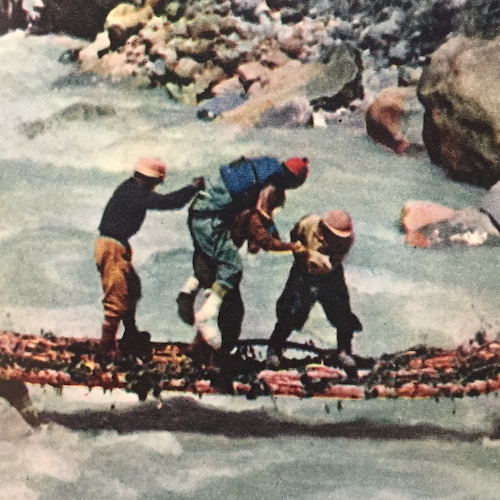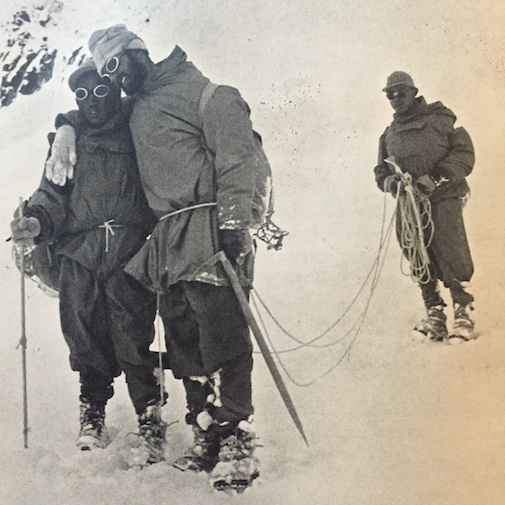ANNAPURNA: CONQUEST OF THE FIRST 8000-METRE PEAK
Approximate Reading Time: 3 minutes.
I MENTIONED MAURICE HERZOG’S BOOK IN AN EARLIER POST ON MOUNTAINEERING LITERATURE AND THE FACT THAT IT IS THAT IT WAS SUCH AN IMPORTANT BOOK FOR ME.
Since I read it I subsequently found out that it has had its fair share of controversy but we have to remember that I tucked into this mountain adventure as a 13 or 14 years old, still a few years away from the freedom to do and to go where I wanted for my holidays. Mountain tops were distant dreams. These kind of adventures were to me universally super-human and special. There was no thought about the integrity or morality of the accounts or the decisions of those involved. There were no grey areas. This was heroism.
- Brows a comprehensive list of the best books on Himalayan Mountains.
- Browse a list of other books about Annapurna
On the 3rd of June 1950 Maurice Herzog and Louis Lachenal became the first men to climb one of the world’s 14 mountains over 8 thousand metres in altitude. The author starts the foreword thus:
“The whole of this book has been dictated at the American Hospital at Neuilly where I am still having rather a bad time.”
HE HAD NO FINGERS. OF COURSE HE COULDN’T WRITE IT HIMSELF.
This was the starting point of my worship of the book, and if truth be told my youthful worship of Herzog himself. The protagonist lost not only his toes but all his fingers in this extraordinary first ascent. To my young imagination this expedition was the epitome of courage in a supremely inhospitable environment - inhospitable not only on the mountain but during the walk in through the forests and foothills. Unlike Everest Annapurna did not have a history of teams approaching it. There was no path to reach the mountain’s foot, let alone its summit.
For those looking for a classic adventure the first half of the book can be a little slow as it goes into logistical expedition details. It was just what I wanted. Keep in mind I had only ever climbed the stairs at that age, I just dreamt of ice and rock. So I saw all these Himalayan accounts as good preparation - I was learning what was required to launch an assault on a large mountain. The fact that it was the late 80s and things had moved on a fair bit didn’t seem to cross my mind.
PAIN, FROSTBITE, BROKEN BONES, LOSS OF FLESH WHAT MORE COULD A YOUNG BOY WANT?
The part of the book which deals with the ascent and the truly epic descent is riveting. How can it not be? The young reader laps up the gory details with the insatiable hunger of a voyeur. Pain, Frostbite, Broken Bones, Loss of Flesh what more could a young boy want… from the safety of an armchair? Herzog loses a glove, loses extremities and is carried off the mountain in a basket. But it was all worth it. The harder the going gets, the more convinced he appears to be in what he is doing. This kind of singular thinking, this assuredness in the face of doubt and danger was intoxicating (and unknown) to someone stepping gingerly into his teenage years.
One alpine summer, constrained within the walls of my grandmother’s house by an allergic reaction and infection from some insect bite, I could only stand on the kitchen balcony, with its restricted courtyard view, and crane my neck to see buzzards circling in the hot summer air over one corner of rusty mountainside. Herzog's life was the antithesis of mine. But he took me with him that summer and for that I cannot thank him enough.
The book is full of self aggrandisement and machismo. And I mean chock full! Again, I think I lacked both of these ‘qualities’ so Maurice Herzog presented me with the greatest adventure by the greatest of characters. Oh, and apaprently there were some other guys on the expedition too…
Nerd's corner: Has anyone ever actually seen the First UK edition in a dust jacket?



